Historico-Critical Inquiry into the Origin of the Rosicrucians and the Free-Masons
– Thomas De Quincey
[Heavily abridged from the Introduction and Chapter 1 of Confessions of an English opium-eater, with Levana, the Rosicrucians and Freemasons, Notes from the pocket-book of a late opium-eater, etc. De Quincey, Thomas. London, W. Scott, 1886.]
There is a large body of outstanding problems in history, great and little, some relating to persons, some to things, some to usages, some to words, etc., which furnish occasion, beyond any other form of historical researches, for the display of extensive reading and critical acumen.
1. In reference to persons, as those which regard whole nations—e.g., What became of the ten tribes of Israel?
Did Brennus and his Gauls penetrate into Greece?
Who and what are the Gipsies? or those, far more in number, which regard individuals; as the case of the Knights Templars—of Mary Stuart—of the Ruthvens (the Gowrie Conspiracy).
Who was the man in the Iron Mask? Was the unhappy Lady of the Haystack, who in our own days slept out of doors or in barns up and down Somersetshire, a daughter of the Emperor of Germany?
Was Perkin Warbeck three centuries ago the true Plantagenet?
2. In reference to things; as who first discovered the sources of the Nile?
Who built Stonehenge?
Who discovered the compass?
What was the Golden Fleece?
Was the Siege of Troy a romance, or a grave historic fact?
Was the Iliad the work of one mind, or (on the Wolfian hypothesis) of many?
What is to be thought of the Thundering Legion? of the miraculous dispersion of the Emperor Julian’s labourers before Jerusalem? of the burning of the Alexandrian Library, etc.
Who wrote the Εὶκών Βασιλκή?
Who wrote the Letters of Junius?
Was the Fluxional Calculus discovered simultaneously by Leibnitz and Newton; or did Leibnitz derive the first hint of it from the letter of Newton?
3. In reference to usages; as the May-pole and May-day dances—the Morris dancers—the practice (not yet extinct amongst uneducated people) of saying “God bless you!” on hearing a person sneeze, and thousands of others.
4. In reference to words; as whence came the mysterious Labarum of Constantine? etc.
Among the problems of the first class, there are not many more irritating to the curiosity than that which concerns the well-known order of Free-masons.
In our own language I am not aware of any work which has treated this question with much learning.
I have therefore abstracted, re-arranged, and in some respects I shall not scruple to say have improved the German work on this subject, of Professor J. G. Buhle.
This work is an expansion of a Latin Dissertation read by the Professor in the year 1803 to the Philosophical Society of Göttingen; and, in respect to the particular sort of merit looked for in a work of this kind, has (I believe) satisfied the most competent judges.
Coming after a crowd of other learned works on the Rosicrucians, and those of Lessing and Nicolai on the Free-masons, it could not well fail to embody what was most important in their elaborate researches, and to benefit by the whole.
Implicitly, therefore, it may be looked upon as containing the whole learning of the case, as accumulated by all former writers, in addition to that contributed by the Professor himself; which, to do him justice, seems to be extensive and accurate.
But the Professor’s peculiar claims to distinction in this inquiry are grounded upon the solution which he first has given in a satisfactory way to the main problem of the case—
What is the origin of Free-masonry? For, as to the secret of Free-masonry, and its occult doctrines, there is a readier and more certain way of getting at those than through any Professor’s book…
There is an everlasting confusion in the worthy man’s mind between the two questions
—What is the origin of Free-masonry? and what is the nature and essence of Free-masonry?
The consequence is that one idea always exciting the other, they constantly come out shouldering and elbowing each other for precedency
—every sentence is charged with a double commission
—the Professor gets angry with himself, begins to splutter unintelligibly, and finds on looking round him that he has wheeled about to a point of the argument considerably in the rear of that which he had reached perhaps 150 pages before.
I have done what I could to remedy these infirmities of the book; and upon the whole it is a good deal less paralytic than it was…

Hieroglyphische Abbildung und Gegensatz der wahren einfaltigen und falschgenandten Brüder vom RosenCreutz / [Christian Rosencreutz].
IMAGE LINKED: wellcome collection Attribution 4.0 International (CC BY 4.0)
Chapter I – Of the Essential Characteristics of the Orders of the Rosicrucians and the Free-Masons
[Heavily abridged]
I deem it an indispensable condition of any investigation into the origin of the Rosicrucians and Free-masons that both orders should be surveyed comprehensively and in the whole compass of their relations and characteristic marks; not with reference to this or that mythos, symbol, usage, or form: and to the neglect of this condition, I believe, we must impute the unsuccessful issue which has hitherto attended the essays on this subject.
First of all, therefore, I will assign those distinguishing features of these orders which appear to me universal and essential; and these I shall divide into internal and external accordingly as they respect the personal relations and the purposes of their members, or simply the outward form of the institutions.
The universal and essential characteristics of the two orders, which come under the head of internal, are these which follow:
I. As their fundamental maxim they assume—Entire equality of personal rights amongst their members in relation to their final object.
All distinctions of social rank are annihilated. In the character of masons the prince and the lowest citizen behave reciprocally as free men—standing to each other in no relation of civic inequality…
II. Women, children, those who were not in the full possession of civic freedom, Jews, Anti-Christians generally, and (according to undoubted historic documents) in the early days of these orders—Roman Catholics were excluded from the society…
III. The orders make pretensions to mysteries; these relate partly to ends, and partly to means; and are derived from the East, whence they profess to derive an occult wisdom not revealed to the profane.
This striving after hidden knowledge, it was, that specially distinguished these societies from others that pursued unknown objects.
And because their main object was a mystery, and that it might remain such, an oath of secrecy was demanded of every member on his admission…
IV. These orders have a general system of signs (e.g., that of recognition) usages, symbols, mythi, and festivals.
In this place it may be sufficient to say generally that even that part of the ritual and mythology which is already known to the public, will be found to confirm the conclusions drawn from other historical data as to the origin and purpose of the institution: thus, for instance, we may be assured beforehand that the original Free-masons must have had some reason for appropriating to themselves the attributes and emblems of real handicraft Masons: which part of their ritual they are so far from concealing that in London they often parade on solemn occasions attired in full costume.
As little can it be imagined that the selection of the feast of St. John (Midsummer-day) as their own chief festival—was at first arbitrary and without a significant import…
Of the external characteristics—or those which the society itself announces to the world—the main is the public profession of beneficence; not to the brothers only, though of course to them more especially, but also to strangers. And it cannot be denied by those who are least favourably disposed to the order of Free-masons that many states in Europe, where lodges have formerly existed or do still exist, are indebted to them for the original establishment of many salutary institutions, having for their object the mitigation of human suffering. The other external characteristics are properly negative, and are these:
I. Masonry is compatible with every form of civil constitution; which cosmo-political relation of the order to every mode and form of social arrangements has secured the possibility of its reception amongst all nations, however widely separated in policy and laws.
II. It does not impose celibacy: and this is the criterion that distinguishes it from the religious orders, and from many of the old knightly orders in which celibacy was an indispensable law, or still is so.
III. It enjoins no peculiar dress (except indeed in the official assemblages of the lodges, for the purpose of marking the different degrees), no marks of distinction in the ordinary commerce of life and no abstinence from civil offices and business.
Here again is a remarkable distinction from the religious and knightly orders.
IV. It grants to every member a full liberty to dissolve his connection with the order at any time, and without even acquainting the superiors of the lodge: though of course he cannot release himself from the obligation of his vow of secrecy.
Nay, even after many years of voluntary separation from the order, a return to it is always allowed. In the religious and knightly orders, the members have not the powers, excepting under certain circumstances, of leaving them; and, under no circumstances, of returning.
This last was a politic regulation: for, whilst on one hand the society was sufficiently secured by the oath of secrecy, on the other hand by the easiness of the yoke which it imposed, it could the more readily attract members.
A young man might enter the order; satisfy himself as to the advantages that were to be expected from it; and leave it upon further experience or any revolution in his own way of thinking.

Confessions of an English Opium-Eater and Other Writings
By: Thomas De Quincey (Author), Robert Morrison (Author)
“I took it: – and in an hour, oh! Heavens! what a revulsion! what an upheaving, from its lowest depths, of the inner spirit! what an apocalypse of the world within me!”
This edition presents De Quincey’s three finest essays in impassioned autobiography, edited by leading De Quincey scholar and biographer Robert Morrison.
Confessions of an English Opium-Eater launched a fascination with drug use that has continued to our day. Here De Quincey invents recreational drug taking, but he also details both the lurid nightmares that beset him in the depths of his addiction as well as his humiliatingly futile attempts to
renounce the drug. Suspiria de Profundis centers on the profound afflictions of De Quincey’s childhood, and examines the powerful and often paradoxical relationship between drugs and human creativity. In The English Mail-Coach, the tragedies of De Quincey’s past are played out with horrifying
repetitiveness against a backdrop of Britain as a Protestant and an imperial power.
Robert Morrison’s Introduction considers opium use in the nineteenth century, the confession genre, and the three works in detail, focusing on De Quincey’s centrality to his own age and enduring relevance to our own. Morrison also provides detailed and comprehensive annotation, an extensive
chronology of De Quincey’s life, and the most up-to-date and thorough bibliography on the autobiographical works. Finally, the book features three appendices containing manuscript material related to the three texts, never before available in paperback.
About the Series: For over 100 years Oxford World’s Classics has made available the broadest spectrum of literature from around the globe. Each affordable volume reflects Oxford’s commitment to scholarship, providing the most accurate text plus a wealth of other valuable features, including expert
introductions by leading authorities, voluminous notes to clarify the text, up-to-date bibliographies for further study, and much more.
Recent Articles: in this series
 Book Intro: The Secret Doctrine Explore the profound synthesis of science, religion, and philosophy in H.P. Blavatsky's "The Secret Doctrine." Discover the true depth of Theosophy beyond the oversimplified term "Esoteric Buddhism" and uncover the universal wisdom that transcends religious boundaries. A compelling introduction to Theosophical literature and its broader, esoteric truths. |
 Book Intro - The craftsman and freemason's guide Dive into the enigmatic world of Freemasonry with Cornelius Moore's comprehensive guide. Uncover the symbolic rituals, trace the fraternity's historical roots, and gain a deeper understanding of this age-old society. Perfect for Freemasons and curious readers alike. Unlock the secrets of Freemasonry today! |
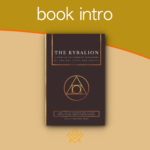 Unravel the secrets of the ancient Egyptian wisdom with our comprehensive guide to the Kybalion, by Three Initiates. Discover its influence on modern thought, the controversies surrounding it, and its seven profound Hermetic principles. Unlock the power of these timeless teachings to transform your understanding of life's mysteries. |
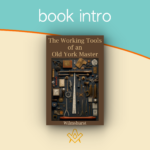 Book Intro - The Working Tools of an Old York Master by Wilmshurst Unlock the Secrets of Freemasonry! Dive into the profound symbolism of 'The Working Tools of an Old York Master.' Discover the hidden meanings behind the square, compass, plumb line, and more. Embark on a transformative journey of personal growth and spiritual enlightenment. Uncover the ancient wisdom that has shaped generations of Masons. |
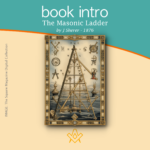 Book Intro - The Masonic Ladder by J Sherer Unlock the mysteries of Freemasonry with "The Masonic Ladder" by J. Sherer - - 1876. This 19th-century guidebook takes readers on a journey through the steps of the Masonic ladder, from the basic principles of the Entered Apprentice to the highest degree of the Sovereign Grand Inspector General. Discover the symbolism, allegory, and values of Freemasonry in this timeless classic. |
 Book Intro - The London mason in the seventeenth century The London Mason in the Seventeenth Century by Douglas Knoop offers a comprehensive examination of the lives and work of masons in the bustling city of London during the seventeenth century. The book delves into the intricacies of their craft, the socioeconomic and political forces that influenced their profession, and the role they played in shaping the architectural landscape of London. |
 Book Intro - History of Freemasonry, Gould, Robert Freke The History of Freemasonry is a comprehensive overview of the origins, development, and evolution of Freemasonry from its ancient roots to the modern era. The book explores the fascinating history of one of the oldest and most mysterious organisations in the world, which has been the subject of much speculation and curiosity over the centuries. - by Robert Freke Gould |
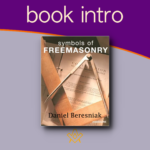 Book Intro - Daniel Beresniak Symbols Of Freemasonry This book is a collection of the symbolic images which Freemasons encounter on their journeys of transformation.' The texts and illustrations form an intimate dialogue whose subject is Freemasonry, and which casts light on the relationship between dreams and reality, reason, intuition and imagination. |
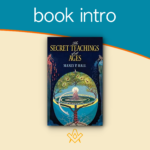 Book Intro - The Secret Teachings of All Ages by Manly P Hall The Secret Teachings of All Ages by Manly P Hall is a comprehensive and in-depth exploration of the various esoteric and occult traditions that have shaped human history. The book covers a wide range of subjects including alchemy, astrology, mysticism, and secret societies, and provides detailed explanations of the underlying principles and concepts. |
 Book Intro - Duncan's Masonic Ritual and Monitor Duncan's Masonic Ritual and Monitor is an impression of the Old York Rite published in New York in 1866. |
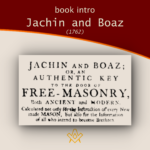 Book Intro - Jachin and Boaz (1762) Thirty two years after Samuel Prichard's Masonry Dissected (1730) a second detailed exposure was published Jachin and Boaz (1762) attributed to the same author, and met with equal distain by Freemasons of the time. However, these exposures offer the masonic historian an invaluable view in to how freemasonry was conducted during its early formation |
 Book Intro - Three Distinct Knocks (c.1760) Giving an exact account of all their proceedings in making a brother, with the three obligations or oaths belonging to the first second, and third degrees of masonry, viz. The entered apprentice, fellow-craft, and master-mason: with the obligating on belonging to the chair, and the grip and word. |
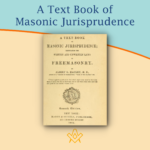 Book Intro - A Text Book of Masonic Jurisprudence An introduction to Albert Mackey's seminal work on Masonic Jurisprudence – the theory or philosophy of Masonic law. The Foundations of Masonic Law are to be found in the Landmarks, or Unwritten Law, and in the Ancient Constitutions, or the Written Law. These constitute the subject matter of the book. |
 Book Intro - The Perfect Ceremonies Of Craft Masonry 1871 A beautiful example of a the rituals, produced in a Medieval illuminated script style. Facsimiles still exist of this illustrated ritual book, of which the most authentically produced version is that available from the Scottish Rite Masonic Book Club. |
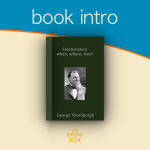 Book Intro – Freemasonry; when, where, how? Introduction to Freemasonry; when, where, how? By George Thornburgh |
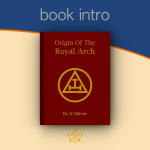 Book Intro - Origin Of The Royal Arch An introduction to the Origin of the Royal Arch, through the eyes of the English nineteenth century masonic author Dr G Oliver (1782–1867) |
 Book Intro – Symbolical Masonry Symbolical Masonry is a treasure-house of Masonic lore, including discussions of key concepts of the first three degrees, along with an extensive study guide. |
 This month we look at – 'A portrait gallery, with biographical sketches of prominent freemasons throughout the United States' |
 Extracted and abridged from The Mystic Tie: Or, Facts and Opinions, Illustrative of the Character and Tendency of Freemasonry By Albert Mackey, |
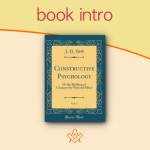 Book intro - Constructive Psychology The introduction to Constructive Psychology or The Building Of Character By Personal Effort by J D Buck a masonic author |
 book intro - Cagliostro: the splendour and misery of a master of magic Preface to the book by William Rutherford Hayes; Cagliostro: the splendour and misery of a master of magic |
 book intro - Origin of the Rosicrucians and the Free-Masons Historico-Critical Inquiry into the Origin of the Rosicrucians and the Free-Masons – Thomas De Quincey |
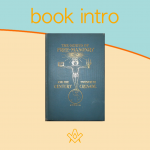 Book Intro - The Genius of Freemasonry The Genius of Freemasonry: “Has any brother anything to offer for the good of Masonry?” The following pages are the author’s answer to that question. |
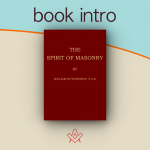 Book Intro - The Spirit of Masonry An essential source for anyone interested in exploring the inner mysteries of the Masonic Fraternity. |
 Book intro - History of Freemasonry Introduction to a classic masonic book by J. G. Findel, History of Freemasonry published 1866 |
 The Book of Constitutions for the Ancient Grand Lodge or Ahiman Rezon |
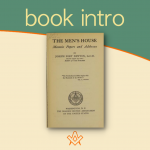 A short introduction to The Men's House, a collection of masonic papers and addresses |
 This is a general survey of Masonic origins, history and philosophy. It was at one time given to every new Mason in Iowa. |
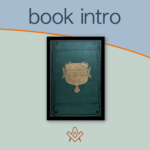 Book Intro - The Discrepancies of Freemasonry Written almost 150 years ago, this book contains wisdom still relevant today. |
 Book Intro - The Principles of Masonic Law "The first great duty, not only of every lodge, but of every Mason, is to see that the landmarks of the Order shall never be impaired". |
 Published in 1911, this fascinating book is equally relevant for the 21st century Mason with an interest in the more mystical side of Freemasonry. |
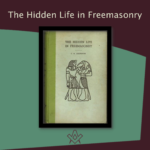 Book Intro - Hidden Life of Freemasonry Introduction to The Hidden Life in Freemasonry (1926) by Charles Webster Leadbeater |
 Book Intro - The Symbolism of Freemasonry Introduction to a classic masonic book; The Symbolism of Freemasonry: Illustrating and Explaining Its Science and Philosophy, its Legends, Myths and Symbols. |
 Book Intro - The Meaning of Masonry This is the Introduction to The Meaning of Masonry, a set of essays which discuss the esoteric side of Masonry |
 Book Intro - Illustrations of Masonry Introduction to Illustrations Of Masonry by William Preston (1742-1818) |
masonic knowledge
to be a better citizen of the world
share the square with two brothers

click image to open email app on mobile device






